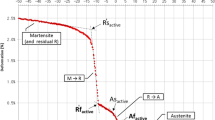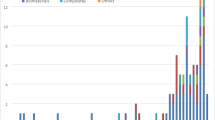Abstract
Experimental studies relating stress to strain under large strain conditions were conducted for 80In15Pn5Ag, at strain rates of 0.21 × 10−3 s−1, 0.42 × 10−3 s−1, and 2.1 × 10−3 s−1; and at temperatures of −65, 0, 25, 75, 100, and 125°C. The ultimate tensile stress of 80In15Pb5Ag as a function of temperature and strain rate was plotted. Similar measurements were made using 63Sn37Pb as a baseline comparison. Tin/lead eutectic was found to have a maximum tensile stress which was 50% higher than 80In15Pb5Ag at 25°C, and approximately 100% higher than 80In15Pb5Ag at 100°C. Under the same conditions, the ductility of 80In15Pb5Ag is always greater than that of 63Sn37Pb.
Similar content being viewed by others
References
S.A. Schroeder, W.L. Morris, M.R. Mitchell, and M.R. James, Fatigue of Electron. Mater. ASTM STP 1153, ed. S.A. Schroeder and M.R. Mitchell (Philadelphia, PA: American Society for Testing and Materials, 1994), p. 82.
Y.-H. Pao, S. Badgley, E. Jih, R. Govila, J. Browning, J. Electron. Pkg., 115, 147, (1993).
H. D. Solomon, J. Electron. Pkg. 112, 123 (1990).
R.N. Wild, “Some Fatigue Properties of Solders and Solder Joints,” IBM No. 74Z000481 (Oswego, NY: IBM Federal Systems Division, October 1975).
Indalloy® Specialty Solders & Alloys, Indium Corporation of America, 1676 Lincoln Ave., Utica, NY (1988).
M. Witt, Surface Mount Technol. Mag. 10, 70 (1996).
B. Gilbert, Surface Mount Technol. Mag. 11, 66 (1997).
Research Solder Kits, Indium Corporation of America, 1676 Lincoln Ave, Utica, NY 13502 (1989).
A.M. Magomedov, Investiya Akademii Nauk SSSR. Metall. 2, 133 (1986).
R.P. Reed, C.N. McCowan, J.D. McColskey, R.P. Walsh, L.A. Delgado, C. Brady, M.W. Austin, and S.A. Kim, “Low-Temperature Properties of Indium, Final Report—Phase 1,” ed. D.E. Newbury (Boulder, CO: Fracture and Deformation Division, Gas and Particulate Science Division, National Bureau of Standards, December 1987).
W. Engelmaier, “Design for Reliability for Surface Mount Solder Attachments: Physics of Failure and Statistical Failure Distribution” (Mendham, NJ: Engelmaier Associates, Inc.).
D.E. Reimer, Soldering and Surface Mount Technol. 6, 52 (1990).
L.K. Edwards, Development of a Viscoelastic Model and Thermal Fatigue Model for the Indium Alloy 80In15Pb5Ag (Ph.D. Thesis, University of Iowa, 1997).
Westinghouse Defense and Electronic Center, “Hermetic Chip Carrier Compatible Printed Wiring Board,” Air Force Wright Aeronautical Laboratories Report AFWAL-TR-84-4082 (July 1985).
Author information
Authors and Affiliations
Rights and permissions
About this article
Cite this article
Edwards, L.K., Nixon, W.A. & Lakes, R.S. Development of stress/strain curves for 80In15Pb5Ag. J. Electron. Mater. 28, 1084–1087 (1999). https://doi.org/10.1007/s11664-999-0242-4
Received:
Accepted:
Issue Date:
DOI: https://doi.org/10.1007/s11664-999-0242-4




